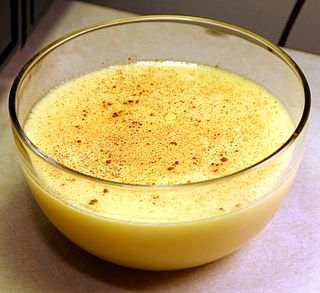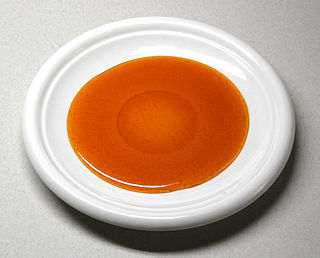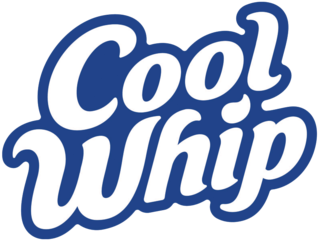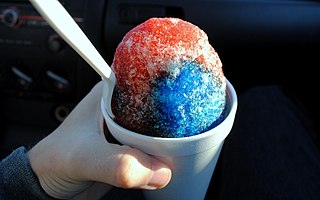
Dessert is a course that concludes a meal. The course consists of sweet foods, such as cake, biscuit, ice cream and possibly a beverage such as dessert wine and liqueur. Some cultures sweeten foods that are more commonly savory to create desserts. In some parts of the world there is no tradition of a dessert course to conclude a meal.

Cake is a flour confection made from flour, sugar, and other ingredients and is usually baked. In their oldest forms, cakes were modifications of bread, but cakes now cover a wide range of preparations that can be simple or elaborate and which share features with desserts such as pastries, meringues, custards, and pies.

Custard is a variety of culinary preparations based on sweetened milk, cheese, or cream cooked with egg or egg yolk to thicken it, and sometimes also flour, corn starch, or gelatin. Depending on the recipe, custard may vary in consistency from a thin pouring sauce to the thick pastry cream used to fill éclairs. The most common custards are used in custard desserts or dessert sauces and typically include sugar and vanilla; however, savory custards are also found, e.g., in quiche.

Caramel is a confectionery product made by heating a range of sugars. It is used as a flavoring in puddings and desserts, as a filling in bonbons or candy bars, or as a topping for ice cream and custard.

A pancake, also known as a hotcake, griddlecake, or flapjack, is a flat cake, often thin and round, prepared from a starch-based batter that may contain eggs, milk, and butter, and then cooked on a hot surface such as a griddle or frying pan. It is a type of batter bread. Archaeological evidence suggests that pancakes were probably eaten in prehistoric societies.

Pralines are confections containing nuts – usually almonds, pecans and hazelnuts – and sugar. Cream is a common third ingredient.

A milkshake is a sweet beverage made by blending milk, ice cream, and flavorings or sweeteners such as butterscotch, caramel sauce, chocolate syrup, or fruit syrup into a thick, sweet, cold mixture. It may also be made using a base made from non-dairy products, including plant milks such as almond milk, coconut milk, or soy milk. Dry ingredients such as whole fruit, nuts, seeds, candy, or cookies may be incorporated.

Fudge is a type of dessert bar that is made by mixing sugar, butter and milk. It has its origins in the 17th century United States, and became popular in American women's colleges in the late 19th century. Fudge can come in a variety of flavorings depending on the region or country it was made; popular flavors include fruit, nut, chocolate and caramel. Fudge is often bought as a gift from a gift shop in tourist areas and attractions.

Rice pudding is a dish made from rice mixed with water or milk and commonly other ingredients such as sweeteners, spices, flavourings and sometimes eggs.

Cool Whip is an American brand of whipped topping manufactured by Kraft Heinz. It is used in North America as a topping for desserts, and in some no-bake pie recipes as a convenience food or ingredient that does not require physical whipping and can maintain its texture without melting over time.

Shaved ice is a large family of ice-based desserts made of fine shavings of ice and sweet condiments or syrups. Usually, the syrup is added after the ice has been frozen and shaved—typically at the point of sale; however, flavoring can also be added before freezing. The dessert is consumed worldwide in various forms and ways. Shaved ice can also be mixed with large quantities of liquid to produce shaved ice drinks.
The following outline is provided as an overview of and topical guide to chocolate:

Instant pudding is an instant food product that is manufactured in a powder form and used to create puddings and pie filling. It is produced using sugar, flavoring agents and thickeners as primary ingredients. Instant pudding can be used in some baked goods.

Semolina pudding or semolina porridge is a porridge-type pudding made from semolina, which is cooked with milk, or a mixture of milk and water, or just water. It is often served with sugar, cocoa powder, cinnamon, raisins, fruit, or syrup. It is similar to grain based halva or halawa. A similar consistency to rice pudding can also be made by using more semolina and by baking, rather than boiling.

Nesquik is a brand of food products made by Swiss company Nestlé. In 1948, Nestlé launched a drink mix for chocolate-flavored milk called Nestlé Quik in the United States; this was released in Europe during the 1950s as Nesquik.

Pie in American cuisine evolved over centuries from savory game pies. When sugar became more widely available women began making simple sweet fillings with a handful of basic ingredients. By the 1920s and 1930s there was growing consensus that cookbooks needed to be updated for the modern electric kitchen. New appliances, recipes and convenience food ingredients changed the way Americans made iconic dessert pies like key lime pie, coconut cream pie and banana cream pie.















